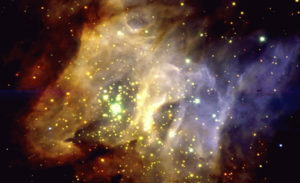The first migrant
Was the first migrant a bacterium from outer space? A bacterium which hid inside a meteorite and brought life to earth more than 3.5 billion years ago? The “seed from space” or panspermia theory has been around since Antiquity and is still discussed among astrobiologists in the scientific search for life in space.
PLANET EARTH was formed about 4.5 billion years ago. In rock types that are 3.5 billion years old, researchers have found the oldest fossil organisms, consisting of thin layers of cyanobacteria. But how did these microorganisms occur?
The idea that life may have come to Earth from elsewhere has occupied scholars since Antiquity. During the 19th and early 20th century, a theory known as the panspermia theory was developed, according to which living cells may have been transported to Earth by celestial bodies such as meteorites and asteroids. New findings in recent decades – for example that bacteria really can survive in space if they are protected from UV light – have led to a revival of the theory.
WE ALSO KNOW TODAY that certain types of meteorites contain a number of small cavities in the form of pores which could potentially act as “shelters”, where microorganisms – equipped with the origins of our genetic code – could have taken hold, shielded from heat and ultraviolet radiation. According to geologist Vivi Vajda, asteroid impacts on land also leave fractured, crushed and pulverised rock with plenty of cavities, thereby facilitating opportunities for any life form to be preserved. The crater processes also entail the formation of underground hot springs in which sulphur bacteria can thrive and new life forms can develop.
“How these processes are linked to the emergence of life on our planet is still a controversial research topic”, says Vivi Vajda.
Currently, the most accepted theory is that life emerged here on Earth. Running water, i.e. hydrogen and oxygen, were already present 4.4 billion years ago together with carbon and nitrogen, providing the necessary building blocks for life. According to current theory, life was formed spontaneously from complex chemical reactions which occurred in the oceans, where molecules containing the carbon element formed simple, single-celled life forms.

This image displays a region in the Milky Way at a distance of about 5,000 light years, where stars which have recently formed in clouds of gas and dust are still heavily obscured. The diffuse radiation is a mixture of starlight scattered by the dust and gas in the area, and atomic and molecular hydrogen line emission. Photo: ESO
BUT IS IT POSSIBLE that at least some of the ingredients for life were formed in space and delivered to Earth long ago by meteorite and comet impacts? Until now, astrobiologists have not found any sign of life on other planets in the form of microorganisms or anything similar. But we know that the gas and dust clouds out in space contain several elements, including carbon, nitrogen and oxygen, which are atoms easily capable of binding to other atoms and thus forming increasingly large molecules. However, most of the compounds which have been identified with certainty in space are relatively small molecules such as hydrogen, water and carbon dioxide.
“There is no direct evidence as yet for the notion that more advanced molecular systems could have been formed in space, with large biomolecules resembling those which are characteristic of life on Earth”, says chemist Petter Persson.
However, the researchers have seen traces of several organic (carbon-based) or even biochemically significant compounds in space. One example is the amino acid glycin which is used by living organisms to produce proteins. Finding traces of organic compounds indicates the possibility that carbon atoms could combine to form complex molecules even out in space.
Text: Pia Romare
Parts of the text above are taken from the book Extrema världar Om sökandet efter liv i rymden [Extreme worlds: On the search for life in space] from 2013 (see more below).
Facts
-
Astrobiological collaboration
-
In 2011, the Astrobiology: past, present and future project at Lund University’s Pufendorf Institute launched an astrobiological collaboration across subject boundaries. The project resulted in a book in 2013, Extrema världar Om sökandet efter liv i rymden, edited by David Dunér. Geologist Vivi Vajda, together with chemist Petter Persson and microbiologist Dag Ahrén were responsible for the part of the project which deals with how life emerged on Earth: Livets ursprung och liv i extrema miljöer [The origin of life and life in extreme environments] by Vivi Vajda and Dag Ahrén and Universums molekylära utveckling [The molecular development of the Universe] by Petter Persson.
-
The panspermia theory
-
The panspermia hypothesis (from the Greek panspermiʹa, ‘a mixture of all types of seed’, from pan– and speʹrma, ‘seed’, ‘germ’) holds that life can be spread through the universe by microorganisms or “life seeds”. In its scientific form, the panspermia hypothesis was first presented by a German, H.E. Richter, in 1865. It was supported by Svante Arrhenius, the Swedish Nobel laureate for chemistry in 1903, who claimed that life seeds were disseminated with the help of radiation pressure from stellar light and that life has always existed. (Nationalencyklopedin, panspermihypotesen. http://www.ne.se/uppslagsverk/encyklopedi/lång/panspermihypotesen (retrieved 11 February 2016))
Now the panspermia theory is topical again. Recently, researchers have conducted experiments in which stones containing microorganisms were thrown from satellites to simulate a meteorite entering the atmosphere. The experiments proved that these organisms survived the most critical part of the journey, i.e. when the meteorite heats up due to friction. The heat energy is effectively emitted from the surface, so the central parts of the stone do not exceed temperatures which the microorganisms can withstand. With these new experiments, the researchers have proven that the theory of “space seeds” definitely holds.





